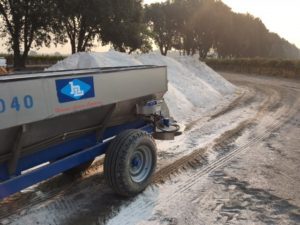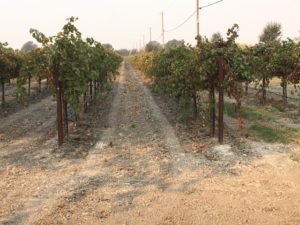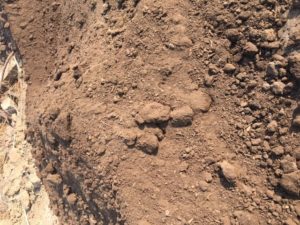Soil amendments are materials incorporated into the soil in vineyards to improve their soils’ physical, chemical, and biological properties. The three most common amendments are gypsum, compost, and lime. In recent years, there has been increasing interest in biochar as this material is becoming more available commercially. The jury is still out on how to best use biochar to improve soils, so we are not going to deal with it here. Also excluded from this discussion are: 1) Fertilizers, which are added to provide nutrients; 2) Mulches, which are applied only on the surface; 3) Cover crops.
Gypsum
Gypsum is probably the most widely used soil amendment in California vineyards. Chemically, gypsum is the calcium salt of sulfuric acid. When it dissolves in water, free calcium cations (Ca2+) and sulfate anions (SO42-) are generated. The pH of the solution or the soil is not affected by gypsum. Sulfate is a source of plant-available sulfur; dissolved calcium provides multiple benefits in soils and is the main reason for gypsum application. Calcium should be the dominant cation on the soil’s exchange complex, ideally taking up around 70% of the cation exchange capacity or CEC. This level of calcium saturation maintains good aggregation and stable soil structure. Good water infiltration and drainage, root penetration, and gas exchange require stable aggregation. These benefits are desirable for any vineyard and are especially important for heavy soils. Gypsum also acts as a water treatment for very low-salt irrigation waters. Surface water from the Sierra Nevada often has very low conductivity; when applied to soils, it strips calcium and other cations from the surface soil. If those cations are not replaced, aggregation fails and soil surfaces turn into dispersed mud. Water can no longer infiltrate below the drippers and starts to run off until it can. Gypsum on or near the soil surface can raise the salt content of the irrigation water to the point where this dispersal no longer happens. A third benefit is the mobilization of sodium (Na+) and excess magnesium (Mg2+) for leaching. This is important for remediating sodic soils and those with a Ca/Mg ratio close to or below 1.0. Calcium in solution will displace adsorbed sodium and magnesium from the exchange complex, taking their place and pushing them into solution. They can then be leached from the soil by additional water.

Gypsum
Calcium sulfate occurs in two forms, anhydrite (CaSO4) and dihydrate (CaSO4 · 2H2O). Strictly speaking, only dihydrate is gypsum, but the term is commonly used for both. The two forms are completely water soluble and their solubility is the same, but quite low. A saturated solution in distilled water (such as rainwater) contains just over a quarter ounce of dissolved calcium sulfate per gallon.
While this sounds like a small amount, the average annual rainfall received in the Lodi area (18 in) is enough to dissolve over 4 tons of gypsum per acre, 8352 lb to be exact. So why do we often see gypsum left on the soil surface, even after the extremely wet last winter?
The problem is the slow rate of dissolution, which is governed by two physical properties. One of those properties is crystal structure. Well-crystallized calcium sulfate has a slower rate of dissolution than poorly crystallized material. Mined gypsum is more likely to have good crystallization than gypsum from power plant desulfurization or recycled wallboard. The other is grain size: The finer the grind, the faster a given gypsum material dissolves. Gypsum materials for ag use are available from many sources. When buying gypsum for soil application, it is most important to watch for a uniformly fine grind (most particles below 1 mm in diameter). Next are low levels of contaminants like heavy metals. Lastly, make sure that the material is spread uniformly over the area to be treated.

Gypsum spread in vineyard
Compost
Compost is organic waste material that has been stabilized by aerobic microbial digestion. This process takes several weeks to months, depending on the waste material. The final nutrient content of compost is also a function of the initial material; manure compost will generally contain more N, P, and K than composted green waste. During composting, the microbes consume much of the initial organic matter, resulting in a reduction in mass, volume, and the generation of substantial heat. When completed, the composting process will yield a relatively stable dark material that is free of pathogens; most weed seeds will also have been killed.
Compost applications provide relatively stable organic matter to the soil, and are a source of slowly available nutrients. Increasing soil organic matter with compost improves soil structure, water holding capacity, nutrient supply, and stimulates beneficial soil organisms and soil health. The effect is largely temporary, since most of the compost will be broken down within a year. Regular applications of compost however can improve the soil over time if they are large enough. In such a system, the need for fertilizer application decreases while soil productivity increases. Unfortunately, nitrogen will be released whenever the soil is active, which in our region is year-round. The nitrogen release is driven by temperature and moisture; this means that the timing and amounts made available often does not match the need of the vines. Supplemental nitrogen fertilization at critical points in the growth cycle may still be necessary.

Compost
Which type of compost to apply depends on what is to be achieved. Increasing soil organic matter is best done with a low nutrient, very stable compost. Soil fertility can be increased with compost that is relatively high in nutrients. Due to the substantial amounts typically applied, transportation costs favor using a compost source close to the vineyard, which often limits the choices. Whatever compost you choose, make sure you have a current analysis of its nutrients, salt content, and heavy metals.
Lime is made by finely grinding limestone and comes in two “flavors”, calcitic or dolomitic. Limestones containing exclusively calcite (calcium carbonate, CaCO3) yield calcitic lime; those containing dolomite (CaMg(CO3)2) result in dolomitic lime. Dolomitic lime should not be used on soils that are already high in magnesium. Lime is used to raise the soil pH of acid soils to within the optimum soil pH range for grape vines, which is between pH 6.0 and 6.5. Vines can grow between pH 4.5 and pH 8.5, but their productivity suffers outside of the optimum range. Below pH 5.5, aluminum and manganese can become toxic. Above pH 7.0, the availability of metallic micronutrients and phosphorus suffers.

Lime
After lime has been applied, the following reaction occurs in the soil solution:
CaCO3 + 2H+ → Ca2+ + H2O + CO2↑
We can see that the “active ingredient” in lime is the carbonate anion, CO3–. It reacts with the hydronium cation (H+, which is responsible for soil acidity) to form water and carbon dioxide, which leaves the soil as a gas. The calcium cation is a useful byproduct, but it is not involved in the removal of acidity. Any carbonate source would work to neutralize soil acidity; limestone is simply the most abundant and therefore the cheapest.
How much lime to apply depends on four factors:
1) the initial soil pH,
2) the target soil pH,
3) the buffer capacity of the soil, and
4) the quality of the lime to be used.
It is intuitive that more lime is needed the larger the spread between existing soil pH and desired soil pH. Just as important is the buffer capacity of the soil, and these differ widely among soils. Soil pH only measures the acidity in the soil solution, but not the total amount of H+ in the soil, most of which may sit on the exchange complex. If we neutralize all the H+ in the soil solution, any H+ on the exchange complex will replenish it almost completely. We need to have the “buffer pH” available to calculate the amount of carbonate needed to remove almost all H+ in the soil. With the soil pH and buffer pH from a soil test and our target pH, we can look up this amount in a table. This value must then be divided by the “grade” of the lime we want to use to find the actual amount to be applied. Pure calcium carbonate has a grade of 1 (100%). If the lime we have contains some sand, clay, or other non-carbonate minerals, its grade will be lower, and we need to apply more than the theoretical value. Likewise, dolomitic lime can have grades above 100%, since magnesium carbonate is lighter than calcium carbonate. Make sure all these factors are considered before applying lime to get the desired result. As mentioned above, applying too much lime (overliming) can cause micronutrient deficiencies.
Dr. Sebastian Braum is the Director of Technical Services – Soil, Irrigation, and Plant Nutrients for The Tremont Group.
Have something interesting to say? Consider writing a guest blog article!
To subscribe to the Coffee Shop Blog, send an email to stephanie@lodiwine.com with the subject “blog subscribe.”
To join the Lodi Growers email list, send an email to stephanie@lodiwine.com with the subject “grower email subscribe” or click on “join our email list” to the right.
To receive Lodi Grower news and event promotions by mail, send your contact information to stephanie@lodiwine.com or call 209.367.4727.
For more information on the wines of Lodi, visit the Lodi Winegrape Commission’s consumer website, lodiwine.com.


